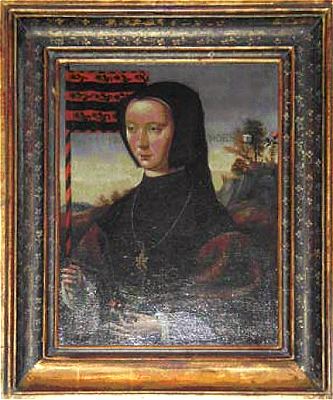 |
PORTRAIT OF A LADY WITH A STANDARDBernhardt Keil Jan Mostaert SN 204, oil on linen, c 1515 From: "The Pages" ARTIST: SUBJECT: |
This portrait is no exception. A woman is shown with head turned in a ¾ -profile. She stands in an outdoor setting, and to the right behind her, we see a rocky formation. Just in front of that, a flower and a die seem to float in air.
In her right hand she holds a small bouquet of flowers. Beautifully dressed in somber colors, her expression is equally somber as she stares ahead into the distance.
PAINTING:
Although her identity is unknown, her face is drawn with the delicacy and refinement characteristic of the artist. Her black widow’s cap & high-collared dress are of fine linen, which Netherlanders much admired during the Renaissance. She is, however, wearing a lot of jewelry, and holds a cluster of pinks, often seen in betrothal or wedding portraits. In other words, there are mixed messages present.
Some features are believed to have been added later: the words mors (death) and vita (life) or matri tally with the theme of mourning indicated by her costume, but they are strangely centered, and the Latin is incorrect. The mysterious suspended die may relate to chance. The flower in the background is repeated in the design on the standard, and matches those in her bouquet.
So we are left wondering: was this originally a wedding portrait?; did her partner die by chance, or mischance?; were the later details then added to reflect her changed circumstances?
The painting was done in the Netherlands during the period of the Northern Renaissance, and is possibly a pendant portrait. And although it is now on linen canvas, it was probably transferred from an original support of a wooden panel.
HISTORIC CONTEXT:
In the 16th c. the Netherlands was prosperous and under the rule of Mary of Burgundy and Maximilian of Austria of the House of Hapsburg.